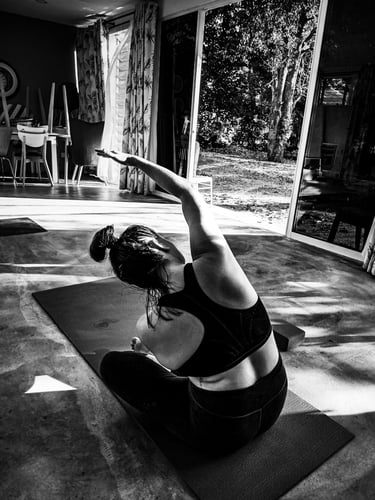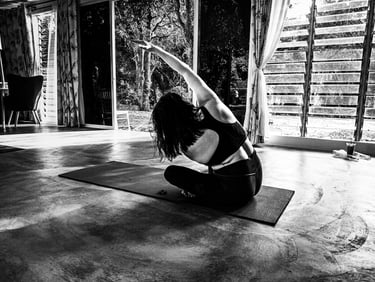Seated Side Bends : Diagnostics
What does this mean in everyday life?
Leaning While Typing
Think about how you might lean more heavily on one hip while sitting at your desk, perhaps favouring the side you use for your mouse. Over time, this habitual weight shift can cause one sit bone to ground more deeply than the other. Similarly, if you often cross one leg over the other, you might notice one knee sits higher. These small, repeated postural habits can translate directly into the lifted sit bone and uneven knees we observe in a seated side bend.
Sitting Position
If your chair is too low, you may tuck your pelvis under, placing more pressure on the tailbone and subtly elevating one side of the pelvis. Conversely, sitting too far back in the chair—without lumbar support—can lead to unconscious shifting of weight to one side. Over time, these postures create the asymmetry that reveals itself during yoga practice.
Typing and Reaching
Many people naturally lean towards their dominant hand, causing one hip to bear more load throughout the day. This asymmetrical habit can manifest clearly in a lifted sit bone. Constantly reaching for items on one side of your desk—or twisting repeatedly in the same direction—further deepens this imbalance, often raising one knee or rotating the pelvis subtly in seated positions.
Driving Posture
Driving for extended periods, especially with one foot active on the pedals and the other relaxed, can also shift pelvic alignment. If the left hip tends to sink or roll back while the right leg works the pedals (or vice versa), this asymmetry may carry over into sitting habits and show up during yoga.
Pocket Use and Carrying Bags
Regularly carrying a heavy bag on one side or keeping your wallet or phone in one back pocket (on a bicycle perhaps) can create habitual shifts in posture. These minor shifts build over time, affecting how the pelvis rests when seated and potentially leading to imbalances in both hips and knees.
During a seated side bend, a lifted sit bone or noticeable difference in knee height often points to pelvic imbalances. These may stem from tight hip flexors or rotators, functional leg length discrepancies, sacroiliac joint issues, or general muscular asymmetry around the pelvis—all common contributors to lower back pain.
Small Habits, Big Insights
The seated side bend acts like a mirror, reflecting the imbalances we may not notice during our everyday routines. By observing the position of the sit bones and knees, we gain clues about how daily habits—desk work, driving, even reaching for a coffee mug—shape our posture and contribute to tension or discomfort. The good news? Once we become aware of these patterns, we can begin to unwind them. And sometimes, that awareness starts with something as simple as sitting and stretching to the side.




Further Reading
Side Bends : Simple, Subtle & Elegant
More Insights
